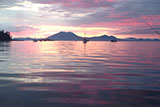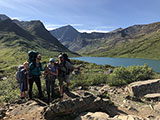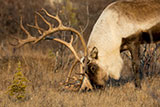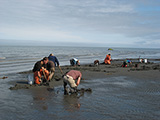Alaska Fish & Wildlife News
May 2018
Bear Spray - From the Other Side
First aid and other tips

For many years I treated bear spray like a first-aid kit – it went in the pack on day hikes and camping trips and I never used it. Over time I learned to actually wear the can of spray so I could grab it quickly, and I practiced with inert spray to get a feel for using it. People who had sprayed bears assured me it works, but I also learned things that changed the way I thought about it.
Blowback is one aspect I never considered.
As a state wildlife biologist, Dave Battle has ... Bear Spray Article Continued
The Pacific Salmon Treaty
Trials, Tribulations and a Tribute: An Editorial

Both the beauty and bane of Pacific Salmon is their highly migratory behavior in the Pacific Ocean, spanning from Northern California to Nome. The beauty being they are able to precisely navigate thousands of miles of open ocean and return to close proximity of where their parents spawned 2-6 years earlier. The bane: many of these migrations transcend geopolitical, federal, state, tribal, regional, and management area delineations. The harvest of the highly migratory Chinook, and to a lesser ... Salmon Treaty Article Continued
Get out and fish. Together.

Alaska certainly doesn’t need any help selling itself as one of the world’s premier sport fishing destinations. It’s true. Trophy salmon – we’ve got them. 30 plus inch rainbow trout? Those too. Trophy grayling, Dolly Varden, lingcod, halibut, rockfish – the list goes on.
But as with all phantom records, if anglers take to the water only in search of a trophy that can be measured in length or pounds, then fishing itself becomes simply another form of human ... Get out and fish Article Continued
Local Knowledge of the Mulchatna Caribou Herd
and Habitat Change in Southwest Alaska

Caribou have been an important part the ecology of the Lake Clark, Bristol Bay, and Kuskokwim River regions in southwest Alaska, and an important subsistence resource for local residents, for at least several thousand years. Archaeological studies in the Lake Clark National Park area have revealed evidence of caribou hunting dating to back to 11,000 years ago.[i] This area was likely inhabited during that time by proto-Athabascan paleohunters, some of whose ancestors would later become the Upper ... Mulchatna Caribou Article Continued
Digging into Common Razor Clam Questions

For many anglers in Southcentral Alaska the transition to spring stirs the thought of making a trip to the Kenai Peninsula to dig razor clams. Planning a trip revolves around the days when we have daylight minus low tides exposing the sandy intertidal clam beaches. The East Cook Inlet shore between the Kasilof and Anchor rivers has historically supported Alaska’s largest sport and personal use razor clam fishery. This fishery has supplied a wide array of memories that often include a clam ... Razor clams Article Continued
